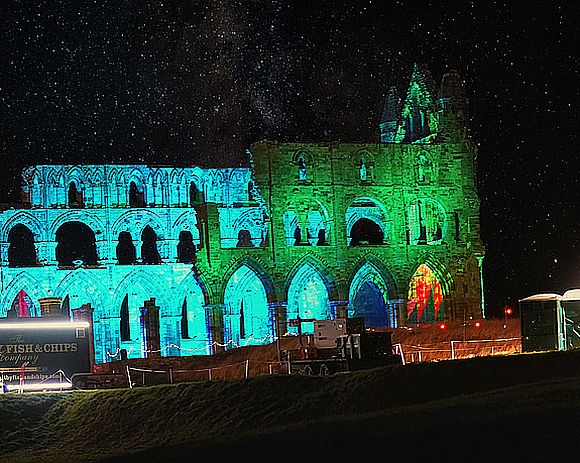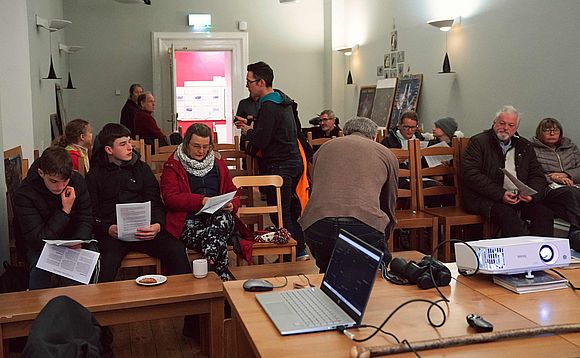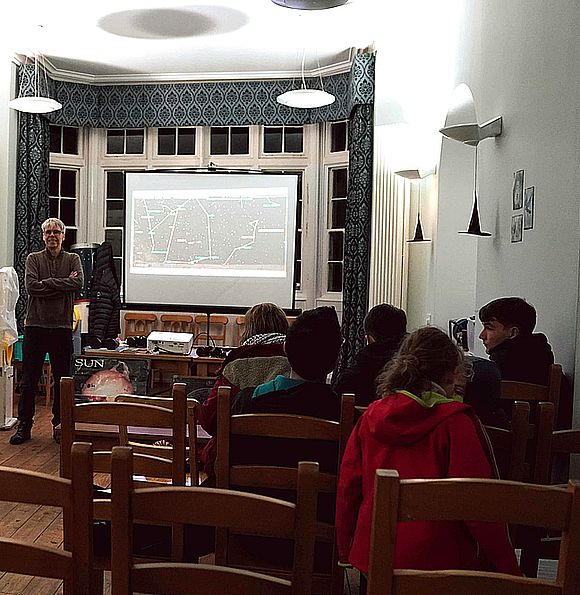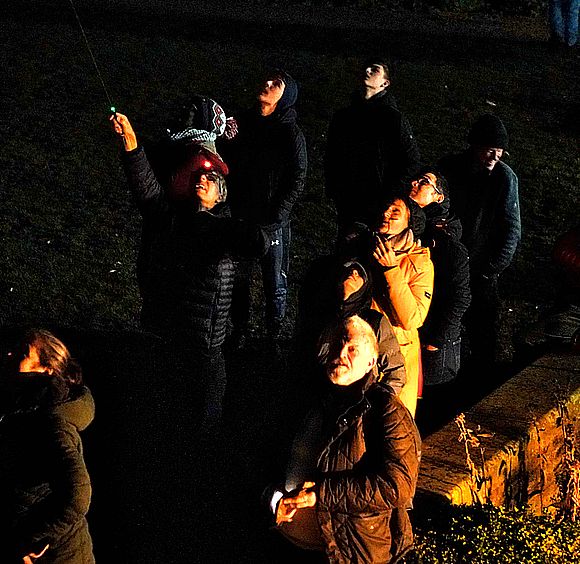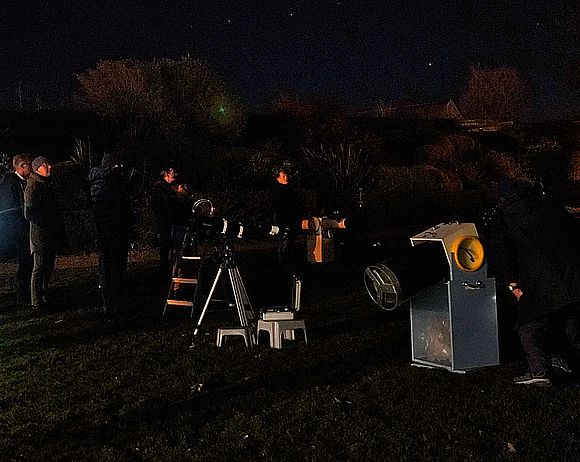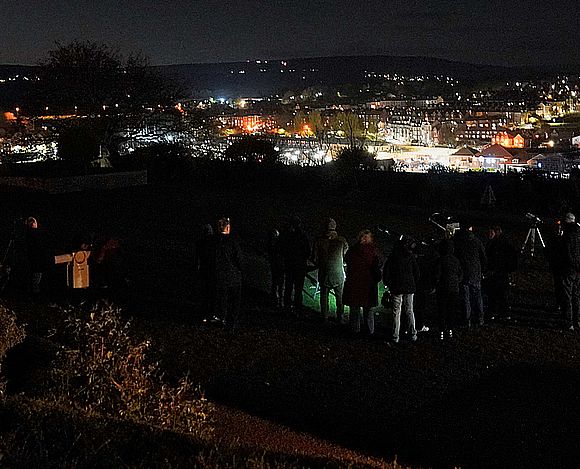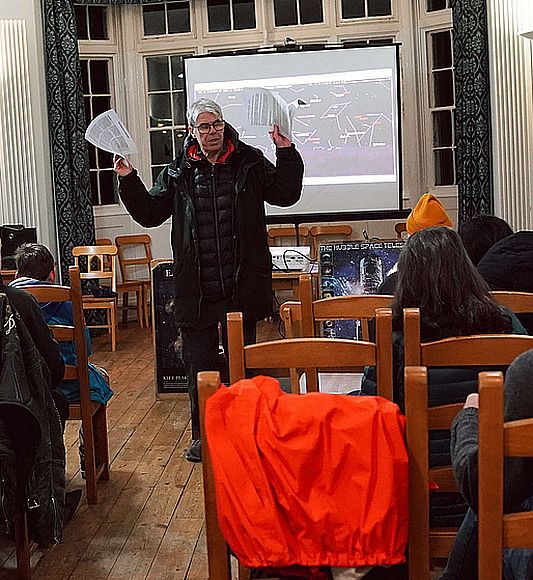The first of the two 'Star Night' events held at Whitby Youth Hostel (Oct 26th), until the weekend in question looked as though it would be a casualty of ill-timed weather, thwarting any observations. By Sunday afternoon, prospects improved dramatically as forecasts implied a window of opportunity for observations to occur.
The usual WDAS crew - having loaded the equipment and sorted out who was going with who, set off for WYH in good spirit arriving well in time.
As usual for Halloween the Abbey was spookily illuminated, but not too brightly spoiling planned observations in the Hostel's rear garden. Having unloaded and set up as usual in the Cholmley Room, we waited for people to be ushered in.
Glynnis, WYH duty manager, informed us that only a few people who had booked were present. We gave it more time, some of the spaces being filled at the last minute. I blame it on the clocks going back that morning! Eventually 16 people were present, a mixture of public, WYH staff and assisting WDAS members. We pressed on. The plan had been to attempt to view comet Lemmon straight away, skies had been clear before we'd set off, but not on arrival (how rude), remaining so until the refreshments interval, too late to view our 'hairy citrus friend'. Typical!
Plan B. Following introductions, Mark talked about comet Lemmon, and T Cor B, highlighting their respective locations and visibility, and in the case of the latter, significance. Various other topics were visited before the refreshment break allowed for some Q&As and inspection of the meteorite collection.
Refreshment break over, the telescopes finally made it into the great outdoors - the hostel garden. Just the two scopes used 10" and 6" Dobsonians plus a set of binoculars - tripod mounted. Skies were not totally clear, cloud scudding overhead on a brisk breeze but conditions were good enough, especially to the east above the illuminated Abbey. Mark had to shout to make himself heard in the wind, pointing out prominent stars, constellations and Saturn, our primary target.
The view of the 'ringless' wonder was surprisingly sharp - the rings clearly not that visible being less than a degree open. Titan was visible - as a speck. Viewing through the eyepieces people were nevertheless impressed.
With limited time our second target was the Andromeda galaxy located high in the sky. Being a nebulous object viewed from an urban location, clarity and resolution were a little compromised, but still good enough to be appreciated by all. Our two hours nearly over we retired back indoors to show a few slides of the Danby Observatory construction before winding up affairs. Perhaps not the numbers the WYH had been expecting, however those present seemed highly delighted with the evening.
Many thanks to Glynnis and the staff at WYH and of course Brian, John, Keith and Richard for their invaluable assistance. On to Wednesday's event.
Conditions for the second event at WYH on Oct 29th were rather more conducive for observations, chiefly clear, less breezy and a little milder. I think this was the first occasion for WYH events that we spent more time outside actually observing than sat in the Cholmley room. Finally!
In a re-run of the previous date, the same WDAS crew headed up to the WYH but this time making use of the garden door at the Hostel, facilitating transportation of equipment via the side path, directly into the rear garden. Brian, Richard, John and Mark undertook this operation, soon having the instruments deployed. Keith managed the IT stuff inside. Our intention was to observe (or try to) Comet Lemmon before it dopped too low.
Public take up of this event was much healthier than the previous one with over 20 people booked in for the evening, so the extra instrumentation brought was needed. Richard and John had managed to track down the comet, and after a quick introduction people excitedly queued to view this 'once in a lifetime' visitor. Two of the scopes targeted a waxing Quarter Moon, the 120mm refractor was aimed toward Saturn.
Comet Lemmon looked so-so, the Moon was quite spectacular however, exquisite detail visible along the terminator. The view of Saturn was pleasingly steady in the eyepiece allowing resolution of the extremely narrow ring system. Titan could be identified close-in to Saturn's disk, as could several other moons of Saturn in the 10" Dobsonian. People were thrilled with all the views.
The view from the parapet, overlooking garden, harbour, town and moors.
Image - Keith D. (Click for larger image)
An obligatory laser pointer tour of constellations followed, Mark weaving a stellar evolution narrative into this. Views of the Pleiades and the Perseus double cluster were available at the same time. We deliberately steered clear of more nebulous targets, moonlight tending to mask them.
With the clock having ticked round to 8:10pm we thought it best to retire inside for refreshments and a warm-up, allowing Mark the opportunity to explain in more detail the impending eruption of T Cor B - and where to look. Several questions were posed, the meteorites were passed around and hand-outs picked up, before our allotted time was up.
Obvious that people had thoroughly enjoyed the evening (perhaps not knowing what to expect - not cloud on this occasion), we wished all a safe journey back in the dark. That just left the small matter of loading up the vehicles again. Thanks to the staff at WYH, indeed Tom, WYH duty manager that night, thought it had been a terrific evening. And of course the WDAS crew without whom the evening would have been very much on a smaller scale.
Looking forward to February when we'll be doing it all over again.
- Log in to post comments

